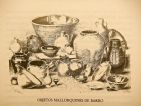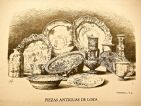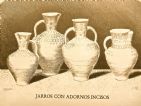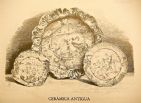
Pottery
 "Pottery plays a very important role on Mallorca. In addition, many ceramicists also make bricks and tiles, among which, depending on the size, some are commonly used to tile some rooms, along with others, to fill openings, decorate stairs and steps. There are other shops (gerreries) which specialize in making all sorts of vessels, jars and plates. For example, there are twenty-one in Palma, concretely in the city itself, and 4 more within the district. These workshops have been included in the number of potter’s because, in addition to cooking and decorative utensils, they also make bricks and roof tiles.
"Pottery plays a very important role on Mallorca. In addition, many ceramicists also make bricks and tiles, among which, depending on the size, some are commonly used to tile some rooms, along with others, to fill openings, decorate stairs and steps. There are other shops (gerreries) which specialize in making all sorts of vessels, jars and plates. For example, there are twenty-one in Palma, concretely in the city itself, and 4 more within the district. These workshops have been included in the number of potter’s because, in addition to cooking and decorative utensils, they also make bricks and roof tiles.
The ceramic pieces made in these factories and of which there is a representative sample in the following illustration, are known by the following names: cossis, large tubs with enamel interiors used to wash clothes and prepare bleach; alfàbies, large enameled tubs serving to preserve oil, dressed olives, pig fat, etc.; mesures d’oli used to measure oil; setrioles used to preserve oil for domestic use; garrafons, oval receptacles with enameled interiors to transport oil and wine, in particular, to America, and with esparto grass on the outside to protect it; ferrades, vessels used when milking; olles of different sizes, used in the kitchen and including their corresponding lids (cobertores); olles coleres, a type of vessel used to prepare marinades and, in particular, to salt cheeses; greixoneres or roasting pots and casseroles; gerres, the most common type on Mallorca and coming in different sizes and without enameling. The latter have more or less of a belly or broad base depending on the town where they’re made. They are used primarily to carry water. Women carry them gracefully on their heads when they’re full and flat when empty, though sometimes they carry them supported on their hips.
In terms of the production of more delicate and elaborate pieces, those in Manacor and Felanitx stand out. In the former, they also make statues, animal figures, decorative garden vases and flower pots, unfortunately in deplorable taste in terms of their shape compared to the beautiful jars whose beauty, free of any color, resides only in precise vertical incisions. Worth noting in this respect is Felanitx where they make very decorative shapes, in truth, according to a very old model and which, as can be seen in the attached engraving, different clays and mollusk shells are the preferred ornamental motifs.
 In many homes there are beautiful pieces of Spanish-Arabic pieces, with shiny copper decorations over a yellow base, pieces of which I myself have a numerous collection at Miramar. There are two main types: one made from fairly coarse clay with vulgar ornamental strokes, the majority being earthenware bowls with a bird or a lion in the center. These are without doubt modern. The other type are finer in quality, older and with scrupulous drawings, at times, with a metallic shine in pale red tones, and, at others, with ornamental motifs in blue over a coppery background.
In many homes there are beautiful pieces of Spanish-Arabic pieces, with shiny copper decorations over a yellow base, pieces of which I myself have a numerous collection at Miramar. There are two main types: one made from fairly coarse clay with vulgar ornamental strokes, the majority being earthenware bowls with a bird or a lion in the center. These are without doubt modern. The other type are finer in quality, older and with scrupulous drawings, at times, with a metallic shine in pale red tones, and, at others, with ornamental motifs in blue over a coppery background.
There is another type of stoneware which doesn’t seem to be Mallorcan in origin. The illustrations are blue and white, and there are very beautiful examples to admire in many opulent homes. The majority come from Savona, Genoa and Naples. In general, then, we cannot doubt their common Italian origin, common even occasionally when we find a Mallorcan name drawn on them. This shouldn’t lead to confusion because, oftentimes, it may have been the name of the person ordering said object."
Archduke Ludwig Salvator of Austria. Las Baleares por la palabra y el grabado. Majorca: General Part. Ed. Sa Nostra, Caja de Baleares. Palma de Mallorca. 1982.

























